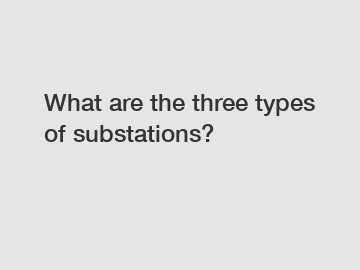What are the three types of substations?
What are the three types of substations?
Substations are significant components of electrical power systems, serving as important nodes in the transmission and distribution network. They play a vital role in maintaining the reliability and efficiency of power supply to end consumers. But what are the three types of substations? Let's delve into this topic and explore the different types that exist.
1. Step-Up Substations:

These substations are responsible for increasing the voltage level of electric power generated at power plants for efficient long-distance transmission. Electricity is generated at low or medium voltage in power stations, but it needs to be stepped up to high voltage levels to reduce transmission losses. Step-up substations achieve this by employing large transformers that raise the voltage for transmission through high-voltage power lines.
2. Distribution Substations:
Once the power has been transmitted through high-voltage lines over long distances, it needs to be brought down to a lower voltage for safe utilization by consumers. This is where distribution substations come into play. These substations receive high-voltage electricity from transmission lines and step it down to a medium or low voltage appropriate for local distribution. Distribution substations are usually located near populated areas to ensure a sufficient power supply to residential, commercial, and industrial establishments.
3. Switching Substations:
Switching substations primarily function as interconnection points in the power grid. They facilitate the transmission of electricity by allowing the network to adapt to changes in the system, such as repairs, maintenance, or load management. Switching substations incorporate switching equipment like circuit breakers, switches, and disconnectors, which enable the isolation and reconfiguration of circuits in case of faults or scheduled maintenance. These substations serve as crucial elements in ensuring the reliability and flexibility of the power grid.
In conclusion, substations are classified into three types based on their specific functions. Step-up substations raise the voltage of power generated at plants for efficient long-distance transmission. Distribution substations step down the voltage for safe utilization by end consumers. Switching substations enable the grid to adapt to changes and ensure the reliability of the power supply. Understanding the different types of substations helps us perceive how these integral components work together to meet our electricity needs. So, next time you power up your devices, remember the importance of these substations behind the scenes.
Are you interested in learning more about safe outdoor prefabricated substation, ggd low-voltage power distribution cabinet, gck low voltage switchgear supplier? Contact us today to secure an expert consultation!
69
0
0


Comments
All Comments (0)